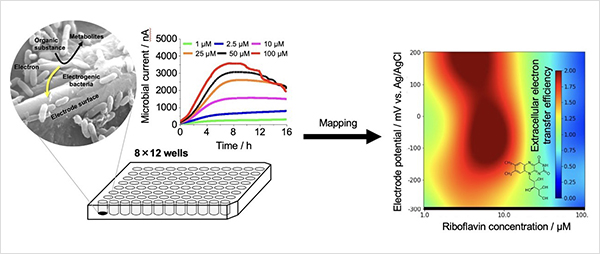Hundreds-fold Electrochemical Measurement Output Brings Data Science to Reveal Microbial Electricity Generation Mechanisms
—High-quality Electrochemical Database May Stimulate Data-Driven Research on Microbial Fuel Cells and Biodegradable Materials—
2022.10.25
National Institute for Materials Science (NIMS)
NIMS researchers have developed a device capable of taking hundreds of times more electrochemical measurements than conventional devices.
(”Multivariate Landscapes Constructed by Bayesian Estimation Over Five Hundred Microbial Electrochemical Time Profiles” Waheed Miran, Wenyuan Huang, Xizi Long, Gaku Imamura, Akihiro Okamoto; Journal: Patterns [October 19, 2022];DOI : 10.1016/j.patter.2022.100610)
Abstract
- NIMS researchers have developed a device capable of taking hundreds of times more electrochemical measurements than conventional devices. By analyzing this device's large amounts of data, the team identified molecular mechanisms that enable electrogenic bacteria to efficiently generate electricity even when subjected to a wide range of electrode potentials. This technique can also be used to analyze materials interacting with microorganisms (e.g., biodegradable plastics), potentially facilitating efforts to discover innovative microbially degradable materials.
- Some microorganisms are able to generate electricity while purifying waste water. Because this eco-friendly power generation mechanism is influenced by various factors, conventional experimental and theoretical approaches to understanding and controlling have been difficult. Data science—the analysis of massive amounts of data—had been considered a potentially effective approach to this problem. However, it requires large amounts of high-quality elctrochemical data with defined conditions and little variability, making it virtually impossible techniqcally and economically.
- This research team recently developed an electrochemical measurement system capable of taking hundreds of times more 3-electrode electrochemical measurements than conventional systems. The team then constructed a high-quality database, analyzed the data using data science techniques to determine the relationship between bacterial electricity generation efficiency and the concentration of external factors enhancing bacterial extracellular electron transfer (right-handed heatmap figure). In addition, the team identified the mechanisms by which riboflavin molecules serve as an extracellular electron transporters, enabling electrogenic bacteria to efficiently generate electricity even when subjected to a wide range of electrode potentials.
- The electrochemical measurement system this team developed was found to be considerably more cost-efficient than conventional systems and exhibited high measurement reproducibility. This is the first research to demonstrate that data science techniques (i.e., analyzing huge amounts of electrochemical measurement data) can be used effectively in microbial electrochemistry research. In addition, because the electric current produced by microorganisms is an indicator of their metabolic activity levels, this system can be used to measure the impact of microorganisms on biomaterials. For example, the rate at which biodegradable plastics disintegrate should be positively correlated with the amount of electric current produced by the microorganisms decomposing them. The system can also be used to measure the electric current produced by the microorganisms associated with various materials. This data could then be analyzed using data science techniques to predict materials with superior physical properties, potentially expediting efforts to discover new, effective materials.
- This project was led by Miran Waheed (JSPS Postdoctoral Research Fellow (at the time of this research), Electrochemical Nanobiotechnology Group (ENG), International Center for Materials Nanoarchitectonics (MANA), NIMS), Gaku Imamura (Senior Researcher, ENG, MANA, NIMS) and Akihiro Okamoto (Leader of ENG, MANA, NIMS). This work was supported in part by the JST Strategic Basic Research Program PRESTO (grant number: JPMJPR19H1) and the Japan Agency for Medical Research and Development (grant number: 21he0322002j0002).
- This research was published in Patterns, an open access journal, on October 19, 2022.

Figure.A developed high-throughput electrochemical device enables simultaneous independent electrochemical measurements in the 96-well electrochemical plate with three electrodes printed at the bottom of every well. High-throughput comparison and analysis of different electrochemical conditions among the wells. Results of the evaluation of power generation enhancement efficiency against riboflavin concentrations and electrode potentials in Shewanella spp. using a Gaussian process regression model, showing high performance over a wide range of electrode potentials in the low-concentration region.
Related files
- International Center for Materials Nanoarchitectonics (MANA)
Contact information
(Regarding this research)
-
Akihiro Okamoto
Group Leader
Electrochemical Nanobiotechnology Group
International Center for Materials Nanoarchitectonics
National Institute for Materials Science
Tel: +81-29-860-4430
E-Mail: Okamoto.akihiro=nims.go.jp
(Please change "=" to "@")
(General information)
-
Public Relations Office
National Institute for Materials Science
Tel: +81-29-859-2026
Fax: +81-29-859-2017
E-Mail: pressrelease=ml.nims.go.jp
(Please change "=" to "@")
(Regarding JST and AMED research funding programs)
-
Department of R&D for Future Creation
Japan Science and Technology Agency (JST)
K's Gobancho, 7 Gobancho, Chiyoda-ku, Tokyo 102-0076, Japan
Tel: +81-3-6272-4004 -
Japan Agency for Medical Research and Development (AMED)
Yomiuri Shimbun Building, 20F
1-7-1 Otemachi, Chiyoda-ku, Tokyo 100-0004, Japan
Tel: +81-3-6870-2200
Same Keywords
Recent Press Release
-
Multiple Autonomous AI Systems Spontaneously Collaborate to Advance Materials Research
2025.12.10
-
Simultaneous Imaging of Intracellular DNA and RNA Using Harmless Light
2025.10.27
-
Development of an AI Device Using Ion Gel and Graphene That Dramatically Streamlines Machine Learning Computations
2025.10.14
